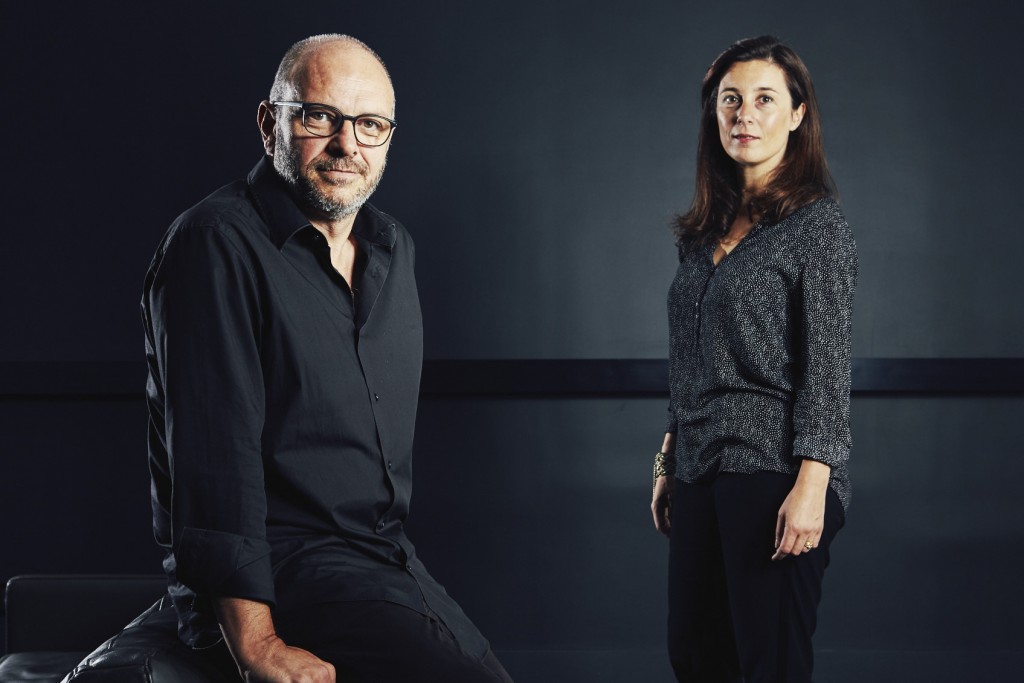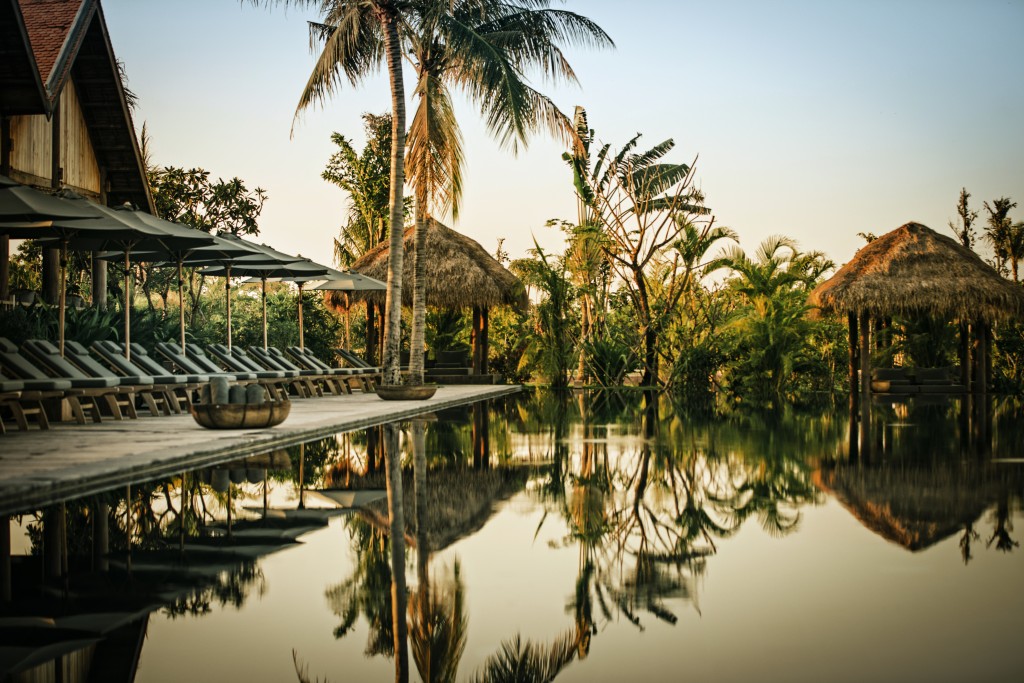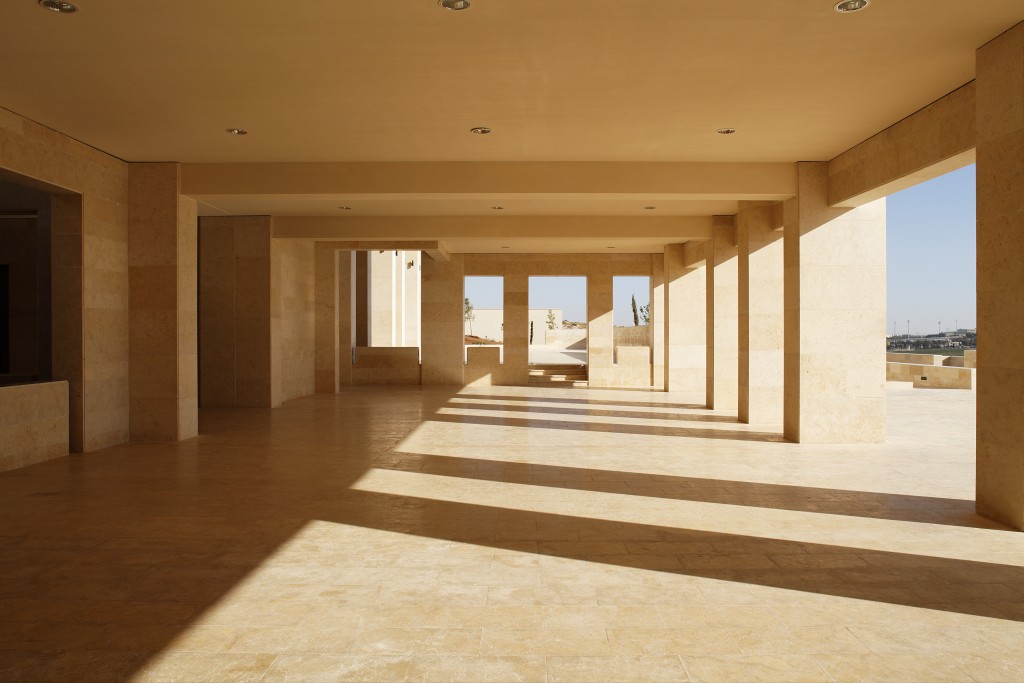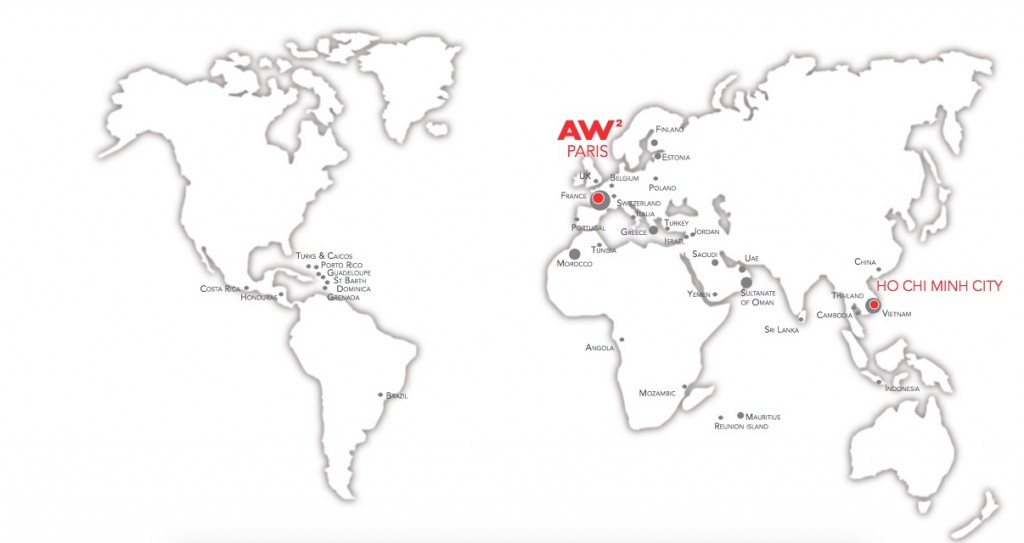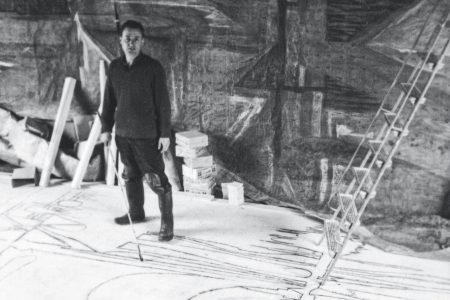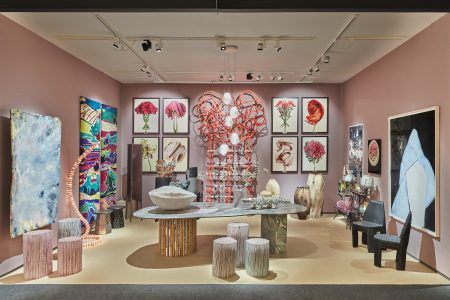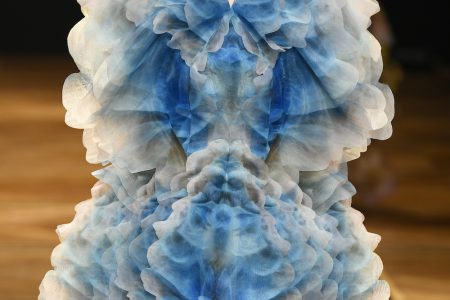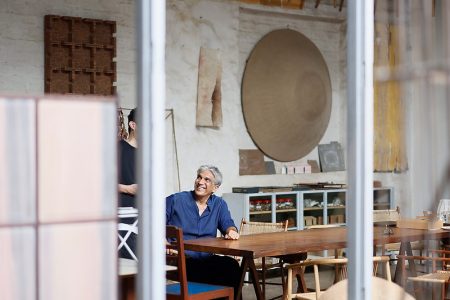AW2: Architects First and Foremost
For almost 20 years, architecture agency AW2 has forged its success. No more limited to an architectural specialty than to a region of the world– despite almost daily contact with its antenna in Ho Chi Minh City–it has succeeded in creating its own path, off the beaten track and away from preconceived ideas. Always flying around somewhere, Reda Amalou and Stéphanie Ledoux talk about their idea of the role of an architect. It’s a clear and uncompromising vision, open to the world and constantly renewed.
Educated at the University of East London, Reda Amalou received his degree in architecture in 1990. After several years spent at London agencies, he joined the Paris workshop of Gérard Thurnauer, where he divided his time between development projects and architectural design projects. In 1997 he founded the AW2 agency, which has since designed projects in more than 25 countries. The most notable of these include the FV Hospital in Ho Chi Minh City, the ESMOD school in Paris and the five-star Nam Hai resort in Hoi An, Vietnam. Reda Amalou is Vice Chairman of AFEX (French Architects Overseas), which includes about 200 French architectural firms. He has also contributed to many publications and participated in conferences and events including the “Long Walls” exhibition on the theme of urbanism, held in Athens, and the Architecture Biennale in São Paulo. Stéphanie Ledoux studied at the École Spéciale d’Architecture, in Paris, where she was awarded the Prix du Meilleur Diplôme. Studying as well at the University of Wisconsin in Milwaukee, she continued her training in Paris with Jean-François Lagneau, chief architect of historic monuments. She subsequently handled research projects for the urban development department of Marne- la-Vallée, then worked for several Parisian agencies, including that of Fabienne Bulle. Joining AW2, she became a partner in 2002, during which time the agency was taking off, with major international projects. In particular, Stéphanie Ledoux oversaw the realisation of the ESMOD school project in Paris, the Lycées français in Ho Chi Minh City and Amman, the renovation of the Champagne house and the renovation of a 30.000 sqm technical centre belonging to the French Ministry of the Interior.
TLmag: How would you define the architect’s job?
Stéphanie Ledoux: For us, architecture is the ability to transform space, to make it beautiful, functional and full of emotion. What makes our profession so exciting is that it gives us access to a vast universe. Few professional and creative domains offer such richness. We don’t have to choose between its different facets; we can have it all.
TLmag: Don’t you feel forced to choose between beauty and functionality?
Reda Amalou: We fully accept the formal side of our architecture, which also has a very practical side. In our approach, the notion of context, which feeds reflection, is at the heart of every project. Just like the intelligence of the site or the cultural approach, the function is a basic element of the emotion that our architecture should produce. In the 20th century, architects took only the “function” from the phrase “Form follows function”. They abandoned the aesthetic side for ideological reasons, which, in my opinion, was a mistake.
TLmag: How do you define the style or signature of AW2?
R. A.: We have our own way of designing, of using rhythm and a certain sobriety in our choice of materials. We adopt a very structured, formal style. Each time that we tried to make a curve, by the fifth version it had become a square!
TLmag: What is your work method? R. A.: We have no ready-made solutions; we adapt ourselves each time to the context of the project. We face very different sites and climates that oblige us to find tailored solutions and production modes. We work within the constraints of climate, orientation and materials, which leads us to approach the architecture in a dedicated way for each project.
S. L.: The idea of humility is important. Not to muzzle us; on the contrary. The relationship with the site is in our ability to listen to it, to hear it, with all of its specific parameters and constraints, and then to intervene to enhance it.
TLmag: Is your architecture influenced by social issues?
R. A.: For us, architecture is always at the heart of the discussion. We are architects and we don’t wish to try to be something else. We believe that approaching architecture through other subjects such as philosophy or sociology is trying to give it crutches. Doesn’t architecture speak enough by itself?
S. L.: We don’t have to make any excuses. The architect’s work is legitimate as it influences how we live. It is a fully fledged mission that, for us, is more related to the search for quality that any social pressure.
R. A.: Our job is to see living conditions in their context and to invent an architecture without language, which comprises designs and plans. Our legitimacy is in the judgement of the people who will use our architecture. If something comes out of it that makes them experience an emotion, then we have succeeded in touching them. That is our artistic sanction. Even if we don’t consider ourselves artists any more than philosophers…
TLmag: Is the ecological dimension important in your projects?
S. L.: It is very important although we do not feel compelled to add an environmental dimension to meet the requirements of a list of environmental specifications. For us, eco-architecture really follows from a bioclimatic approach; that is to say, from the result of using the site conditions as a starting point for choosing how to install or use this or that feature of the site to enhance it. At the moment of conception, we first think about how to approach the building, to integrate it into the site, and the ecological dimension is directly related to this reflection.
R. A.: We don’t want to use an environmental aspect as a crutch for our architecture. It is either ecological or it isn’t, but if it is, this is present from the start of the conception, it isn’t part of a calculation.
TLmag: There is a real sense of pragmatism in your approach. How would you describe it?
R. A.: It’s true. I have an English friend whose motto is: “Life is too short for French movies!” We don’t need to intellectualise everything we do.
S. L.: Part of our philosophy is not to make things unnecessarily complicated. We only include complexity if it adds value to the project. That is equally true for how we work in the day-to-day. The atmosphere at the agency is as calm as possible. This is part of the same logic of only undertaking a project if it makes sense.
TLmag: What is your agency’s way of working?
S. L.: We question ourselves every day. We avoid creating overly generic systems that do not adapt to our projects, which are so diverse. Our method to avoid being overwhelmed is to regularly ask the question of what approach to adopt. We try to address all issues from the front, including issues of communication and internal organization. Everything is ultimately important to take into consideration and contributes to the success of the agency.
R. A.: We have always seen the agency as a tool, which has to function perfectly to support us in producing our work in the best possible conditions.
TLmag: How does your international dynamic impact your architectural approach?
R. A.: We are more sensitive today to cultures that come together in the plural. We do not think about difference, we admit it, expect it; it interests us because it allows us to find the idea behind the project. In a context where everyone tends to look inwards, we have this interest in difference. It enriches our work. The architect is a generalist, he needs to feed all these external phenomena to create a coherent whole that will form the qualitative basis of the architecture. Broadening our influences with other territories, other cultures, other climates, other customs, is truly exciting.
S. L.: Culture remains the basis, the creative soil, but not the end-point. We do not guarantee multi-culturalism. The architecture is the end-point!
TLmag: In the design and construction phases, you consistently turn to local resources and expertise. How would you define the added value this brings to your projects?
R. A.: Working with people locally lets you save on resources. It also has a social and environmental side, because you import less. Now, there are different scenarios. It’s simple when we want to call on well-established local expertise, such as in Morocco, where it is we who are requestors and who are learning the techniques. The process is more complex when it comes to reusing forgotten skills. I’m thinking about Vietnam, where we worked with a French journeyman carpenter who taught woodworking to local businesses.
S. L.: In the logic of our contextual architecture, using expertise is paramount. We look at the site, as well as the local potential. If resources are not available locally, we must import them. We maintain an authentic approach.
TLmag: The agency is brimming with all these influences, whether from the Anglo-Saxon culture, since you studied in London, Reda, or from the projects you are working on abroad. How would you define the identity of AW2?
R. A.: We are often seen as foreigners, even in France. We are part of the panorama of French architects who work abroad but I am not very fond of labels in general. I willingly accept the idea of being part of the French architectural panorama, but the richness of our approach is to stay open to a multitude of possible options and different sensibilities.
S. L.: The image of a French architectural agency can be attractive to foreign clients, who probably see it as a guarantee of creativity, but AW2 defines itself more by the ability to work internationally with agencies who use a work process based on the Anglo-Saxon model.
R. A.: For me, an identity isn’t something you can pin on the wall: it is by its nature moving and elusive. If you try to define it in a definitive way, then the identity itself is dead.
TLmag: You design interiors and hotels at the end of the world, as well as educational facilities and luxury boutiques. Is this eclecticism intended? R. A.: In the choice of projects, if we are convinced that an idea is good and the project is interesting to develop, we will throw ourselves into the adventure.
S. L.: We share the same approach and a similar interest in working with a craftsman to develop furniture as in collaborating with landscapers on much larger development subjects, or with a heating engineer, or any other trade.
TLmag: Does this openness to a vast palette of projects allow you to follow the realisation of the projects in their entirety, a little like the Art Nouveau architects who designed motifs, interiors and furniture as a complete work or art?
S. L.: Absolutely. We have the opportunity to intervene at different levels of the project. We work both on the floor plans as well as on the details. It really is a particularity of our agency that allows us to strengthen our ideas.
R. A.: As soon as the direction has been found for the project, everything that takes place must be coherent. From the floor plan to the door handles, we follow our logic: the discussion remains limpid, and must not be dissolved. We are not integrists in our approach to projects, but we are strict and very protective of the architectural idea.
TLmag: Many of your projects have been carried out for the luxury market. What have these experiences brought you?
S. L.: We always associate luxury with experience and know-how. Working in the luxury market lets us invent, create and generate experience in forms, emotions, materials… It also allows us to be in contact with extraordinary experts and to thereby experiment with luxury through the quality of research.
R. A.: It’s also a luxury to take the time, to be able to spend a year on a chandelier or mirror, as we did with Veronese for the “Patek Philippe” salon in London. Each element in Murano glass, however insignificant, had its own importance. What we love about the luxury market is its extreme side; pushing design to the smallest details.
TLmag: Based on these notions of time and expertise, how does architecture find its place between tradition and innovation?
R. A.: The two are not incompatible; they even go hand in hand. The idea of tradition is poorly defined and often misunderstood: the idea that it must be something old is senseless. For an object to have a place in history, it must have an innovative dimension. At the companies with which we work, it is not the old aspect of their expertise that is interesting but the fact that they constantly renew themselves. It is by basing themselves on a deep knowledge of their subject that they successfully innovate. And this is the same for us in the field as soon as we are confronted by this traditional know-how, we realise that it is all highly innovative. Otherwise, it would not persist!
There are their references: Hotels & Interiors
Silver Sands resort, Grenada, 15.000 sqm, under construction – Villa Bibbia, Sicilia, 5.000 sqm, refurbishment of a boutique hotel, concept design – Chedi Dhapparu, Maldives Islands, 10.000 sqm, 5 star resort, design in progress – Al Khairan resort, Sultanate of Oman, 20.000 sqm, 5 star resort, under construction – Barka resort Village, Sultanate of Oman, 15 000 sqm, design in progress – Marriott Taghazout, Morocco, 28.000 sqm, resort & villas, competition, 1st prize – Cayo Largo resort, Puerto Rico, 22.000 sqm, resort & villas, concept design – Ani Villa Dikwella, Dikwella, Sri Lanka, 2.200 sqm, 3 villas, completed – Phum Baitang, Siem Reap, Cambodia, 9.000 sqm, 5 star resort, completed – Six Senses Condao, Condao Island, Vietnam, 26.000 sqm, 5 star eco-resort, completed – Norman Estate, Danang, Vietnam, 5.800 sqm, residential & club house, completed – Dar Sabra, Marrakech, Morocco, 1.500 sqm, 10 suites, completed – Jabal al Akdhar, Sultanate of Oman, 21.000 sqm, 5 star hotel, concept design – Chedi Tamuda Bay, Tangiers, Morocco, 15.000 sqm, resort & villas, under construction – The Nam Hai, Hoi An, Vietnam, 24.000 sqm, 5 star hotel, completed – The Tanai, Providenciales, Turks & Caicos, Caribbean, 50.000 sqm, 5 star hotel, concept design – The Malkai, Barka, Sultanate of Oman, 100.000 sqm, resort, golf course & spa, design stage – Alila Villas, Mui Ne, Vietnam, 22.000 sqm, resort & villas, mock up completed.
Offices, equipements, public buildings
Ani Academy, Dikwella, Sri Lanka, 530 sqm, art school, completed – FV Hospital, Ho Chi Minh City, Vietnam, 2.500 sqm, extension & interiors, completed – Lycée Français of Abu Dhabi, UAE, 5.000 sqm, competition · Maison de Champagne, Reims, France, 6.000 sqm, visits and cellar, under construction – Pôle Multiservices Jean-Jaurès, Paris, France, 34.000 sqm, refurbishment – Lycée français of Sousse, Tunisia, 5.000 sqm, competition · Suncity, Rabat, Morocco, 44.000 sqm, mixed use development, under construction – Lycée Français Marguerite-Duras, Ho Chi Minh City, Vietnam, 9.000 sqm, completed – Lycée Français of Amman, Amman, Jordan, 5.000 sqm, completed – 118 Élysées, Paris, France, 2.500 sqm, office building refurbishment, completed – Université de Bourgogne, Dijon, France, 1.500 sqm, with NFA, completed – 8 Rochefoucauld, Paris, France, 2.500 sqm, office building refurbishment, completed – 21 Boisseau, Clichy, France, 2.400 sqm, commercial, completed – ESMOD Fashion school, Paris, France, 3.000 sqm, refurbishment, completed -Nomad, Tafilalet, Morocco, mobile medical center, concept design – FV Hospital, Ho Chi Minh City, Vietnam, 22.000 sqm, completed – Finnforest Headquarters, Gennevilliers, France, 600 sqm, office building, completed – Museum of Primal Arts, Paris, France, 35.000 sqm, competition with SHL.
Private housing
Villa Saint Barth, 450 sqm, private villa, under construction – Villa in Corsica, Bonifacio, France, private villa, completed · Private Beach Estate, Azziziah, Saudi Arabia, 4.000 sqm, 6 villas & services, design in progress – Private Villa, Paris, France, 300 sqm, completed – Villa Casablanca, Casablanca, Morocco, 1.000 sqm, private villa, in progress – Villas in Bali, Bali, Indonesia, 2.000 sqm, 4 private villas, completed.
Housing
Maisons Innovantes, France, 4.500 sqm, 35 houses, under construction – John Street Development, New York City, USA, 9.000 sqm, condominium, competition – Ourcq-Jaurès, Paris, France, 5.000 sqm, sustainable housing 100 units, competition – Jules-Lagaisse, Vitry-sur-Seine, France, 2.000 sqm, housing 37 units, completed – Pierre-Curie, Le Bourget, France, 2.000 sqm, housing 33 units, completed – Lenox, Tel Aviv, Israel, 2.000 sqm, apartment building, completed – Îlot Saussure, Paris, France, 12.000 sqm, sustainable office building, competition – Albert-Camus, Dijon, France, 3.270 sqm, housing 38 units, with NFA, completed – FVH Housing, Ho Chi Minh City, Vietnam, 5.000 sqm, housing 40 units, completed – Saint-Just, Ivry sur Seine, 8.200 sqm, housing 107 units, completed – Munkkisaari, Helsinki, Finland, 2,4 ha, masterplanning 450 housing units, competition, 1st Prize.
Retail
Patek Philippe Retail outlet worldwide interior concept roll out – Patek Philippe Salons, 400 sqm, London, UK, completed – Maison Patek Philippe, 600 sqm, Beijing , China, completed · Patek Philippe Service centre, 850 sqm, Singapour, completed.
Awards
TripAdvisor Travellers’ ChoiceTM Winner 2016 – ranked second Hotel in Vietnam, The Nam Hai – Top 25 Resorts in Asia in the Condé Nast Traveler UK Readers’ Choice Awards, The Nam Hai – TripAdvisor ‘Hall of Fame’ Award 2015 (five-time winner of TripAdvisor’s Certificate of Excellence) , The Nam Hai – Smart Travel Asia (Hong Kong), 2015 top 25 leisure hotels & top ten spa hotels in Asia, The Nam Hai – Listed in Condé Nast Traveler China Gold List 2015 – Festival Fimbacte 2014, Trophée Argent du cadre de vie pour Les Lodges, maisons innovantes et évolutives – Luxury Travel (Australia), fifth best overseas resort, 2014 Gold List Awards, The Nam Hai – Travel + Leisure magazine, 2014 Top Resorts in Asia, The Nam Hai – ADEME, ‘Bâtiment exceptionnel d’Île- de-France’, Les Lodges: 35 maisons d’avant-garde – Nominated at the AFEX Grand Prix d’Architecture 2014: Lycée Français d’Amman, Jordan – The Smith Hotel Awards 2013, The Eco Award Top 10, Six Senses Con Dao – National Geographic Travelers, June July 2013, World’s Best Ecolodge, Six Senses Condao – Artravel, Artravel Awards 2013, Sun Hotel, Six Senses Con Dao – Condé Nast Traveller, The Reader’s Travel Awards 2012, Best Overseas Spa Hotel, The Nam Hai – Ha+d awards, Six Senses Con Dao, April 2012 – Nominated at the AFEX Grand Prix d’Architecture 2012: Six Senses Con Dao, Vietnam – MIPIM Awards 2012, ‘Best Hotel & Tourism Resort’, Six Senses Con Dao – Hotel & Lodge ‘Best Resort’ 2011 Runner up, Six Senses Con Dao – Green Good DesignTM Award 2011
The Chicago Athenaeum Museum of Architecture and Design & European Centre for Architecture Art Design and Urban Studies, Six Senses Con Dao – Bloomberg International Property Award ‘Best International Small hotel design’ 2010, Six Senses Con Dao – The Chicago Athenaeum Museum of Architecture and Design International Architecture Awards 2010, Six Senses Con Dao – The Chicago Athenaeum Museum of Architecture and Design International Architecture Awards 2010, NOMAD – Bloomberg International Property Award, best Asia-Pacific Small Hotel 2010, Six Senses Con Dao – Hotel & Lodge ‘Best Resort’ 2009, The Nam Hai – CNBC Asia Pacific Architecture Award 2009, The Nam Hai – Asia Spa & wellness festival 2009 Gold Awards: ‘Best Destination Spa, Vietnam’, July 2009, The Nam Hai – Asia’s ‘Best Beach Resort’ TTG Travel Awards 2008, September 2008, The Nam Hai – Arrivals + Departures Australia 2008: ‘Arrival + Departure’s Asian Resort of the Year 2008’, The Nam Hai – Winner Travel & Leisure Best Resort Design Award, 2008, USA, The Nam Hai – Conde Nast Traveler HOT LIST 2007 UK and USA: Top New Hotels and Spas in the World, The Nam Hai – Australia’s Gourmet Traveler 2007: one of the ‘Best of the Best’ new hotels, The Nam Hai – Travel + Leisure USA 2007: ‘The It List’, The Nam Hai – Winner Best New Beach Resort In Asia, 2007, TTG Asia, The Nam Hai – Nominated at MIPIM Awards for 2007, Cannes, France, The Nam Hai, Munkisaari Urban Planning & Housing competition, winning entry,1999, Helsinki, Finland.
